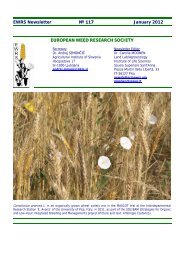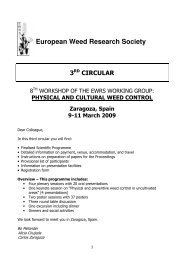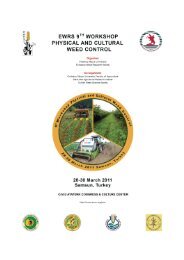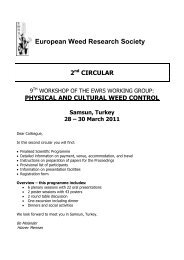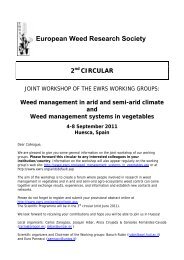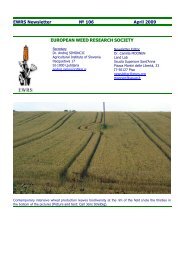Weed biomass
Weed biomass
Weed biomass
You also want an ePaper? Increase the reach of your titles
YUMPU automatically turns print PDFs into web optimized ePapers that Google loves.
What is the basis of early vigour, being an<br />
important trait of weed competitiveness in rice<br />
Lammert Bastiaans, Aad van Ast & Dule Zhao
Cultural weed control<br />
<strong>Weed</strong> control in rice: an excellent example<br />
Standing water: inhibits germination of weed seeds<br />
Use of transplants: provides the crop with a head start
Cultural weed control<br />
<strong>Weed</strong> control in rice an excellent example<br />
Standing water: inhibits germination of weed seeds<br />
Transplanting: provides the crop with a head start<br />
Developments in S.E.Asia<br />
Limiting resources:<br />
• onfarm labour<br />
• water<br />
(land preparation175750 mm)<br />
→ shift towards direct seeded<br />
aerobic rice
Principle: alteration of competitive relations<br />
YL<br />
<strong>Weed</strong>competitive cultivars make use of the same<br />
principle and might be a good alternative option for<br />
minimizing the negative effect of weeds.<br />
N w<br />
S w<br />
Transplanting<br />
Competitive cultivars
Is there genetic variation for WSA (weed suppressive ability?)<br />
Density: 100 300 500 plants m 2<br />
Variety:<br />
APO<br />
IR60080
<strong>Weed</strong> <strong>biomass</strong> used to quantify weed suppressive ability<br />
<strong>Weed</strong> <strong>biomass</strong> (g m -2 )<br />
400<br />
300<br />
200<br />
100<br />
0<br />
2003<br />
APO fitted<br />
APO observed<br />
IR60080-46A fitted<br />
0 100 200 300 400 500 600<br />
Plant number m -2<br />
IR60080-46A observed<br />
<strong>Weed</strong> <strong>biomass</strong>: Y wc = N w / (b w0 + b wwN w + b wcN c)<br />
2004<br />
b wc → crop competitiveness, time of weeding<br />
N c → seeding rate<br />
<strong>Weed</strong>ing at<br />
3 WAS <strong>Weed</strong>ing at<br />
2 WAS<br />
For both years: APO twice as competitive as IR60080<br />
0 100 200 300 400 500 600<br />
Plant number m -2
Traits that favour weed competitiveness<br />
IR8<br />
Traditional IRtype<br />
Yield ton/ha<br />
6<br />
5<br />
4<br />
3<br />
2<br />
1<br />
0<br />
1 2 3<br />
1 2 3<br />
Mono Mix1 Mix2<br />
IR8<br />
Mahsuri
Analysis using a competition model
Identifying traits with a high potential<br />
Most promising:<br />
early growth<br />
height<br />
characteristics<br />
Relative sensitivity for weed <strong>biomass</strong><br />
0.0<br />
-0.5<br />
-1.0<br />
-1.5<br />
-2.0<br />
-2.5<br />
early early growth max.<br />
growth height rate Kdif SLA height
Extensive field study<br />
40 Genotypes of Upland/Aerobic Rice<br />
Germplasm<br />
• Aus (3), Indica (7), Japonica (23), Indica × Japonica (7)<br />
Variety type<br />
• Traditional (4), Improved (36)<br />
Plant type<br />
• Erect ↔ Droopy<br />
Plant height<br />
• 90 – 155 cm<br />
Experiments for determination of:<br />
In weedfree plots: Several (non)destructive plant traits<br />
<strong>Weed</strong>free yield<br />
In weedy plots: <strong>Weed</strong>y yield<br />
<strong>Weed</strong> <strong>biomass</strong>
Large genetic variability in WSA (weed suppressive ability)
Indic and aus germplasm most suitable donors<br />
Yield (Mg ha -1 )<br />
4.0<br />
3.5<br />
3.0<br />
2.5<br />
2.0<br />
1.5<br />
1.0<br />
0.5<br />
0.0<br />
LSD YF = 0.54<br />
LSD YW = 0.54<br />
LSD W = 39<br />
Indica Aus Indica/<br />
japonica<br />
Short<br />
japonica<br />
Germplasm group<br />
Yield reduction<br />
<strong>Weed</strong>y yield<br />
<strong>Weed</strong> <strong>biomass</strong><br />
Medium<br />
japonica<br />
Tall<br />
japonica<br />
250<br />
200<br />
150<br />
100<br />
50<br />
0<br />
<strong>Weed</strong> <strong>biomass</strong> (g m -2 )
Correlation among traits<br />
Trait <strong>Weed</strong> Biomass <strong>Weed</strong> Rating<br />
Early vigour (4 WAS) 0.68 ** 0.82 **<br />
Height (WAS) 0.66 ** 0.70 **<br />
Final height (4 WAS) 0.24 ns 0.18 ns<br />
Crop Biomass 0.33 * 0.43 *<br />
Early vigour and early height are strongly negatively correlated with<br />
weed <strong>biomass</strong> indication that these traits are related to WSA
Role of plant type<br />
Erect<br />
Droopy
Droopy plant type is not a favourable attribute<br />
Within mixed population of 40 cv’s<br />
Yield w<br />
<strong>Weed</strong> <strong>biomass</strong><br />
Erectness 0.71** − 0.68**<br />
Within japonica germplasm of 23 cv’s<br />
Yield w<br />
<strong>Weed</strong> <strong>biomass</strong><br />
Erectness 0.50* − 0.64*<br />
A more erect plant type was correlated with higher yields (more even light<br />
distribution in the canopy). Surprisingly there was no penalty regarding WSA,<br />
as erectness was associated with a lower amount of weed <strong>biomass</strong>.
WSA and yielding ability are compatible<br />
<strong>Weed</strong> <strong>biomass</strong><br />
Rice Yield Experiment 1 Experiment 2<br />
<strong>Weed</strong> free yield − 0.67**<br />
<strong>Weed</strong>y yield − 0.84** − 0.76**<br />
The highest yielding cultivars, both in weedfree and weedy<br />
conditions, were best able to suppress weeds. This suggests<br />
that there is no tradeoff between WSA and yielding ability
How to select for early vigour?<br />
In field experiment:<br />
Visual score<br />
• Subjective<br />
• Requires sufficient seed<br />
Selection on individual plants<br />
Requirements<br />
• Easy quantifiable \ objective traits<br />
• Nondestructive observation<br />
Additional consideration:<br />
• Are weedsuppressive cultivars characterized by a specific growth<br />
strategy?
How to select for early vigour?<br />
Cultivar<br />
Genotype<br />
group<br />
Early<br />
vigour<br />
score<br />
[ 1 – 9 ]<br />
<strong>Weed</strong><br />
<strong>biomass</strong><br />
[g / m 2 ]<br />
B6144F Indica 7.2 128 Strong<br />
Vandana Aus 6.9 129 Strong<br />
<strong>Weed</strong><br />
suppressiveness<br />
APO Indica 6.1 143 Mediumstrong<br />
IR60080 Tropical<br />
japonica<br />
5.2 183 Medium<br />
Four cultivars that differed in weed suppressiveness and early vigour<br />
were selected for further experimentation
Growth chamber experiment<br />
Germination in coarse sand<br />
Transplanting after 10 days<br />
Growth on water culture
Growth chamber experiment<br />
Frequent harvests<br />
5 8 12 15 19 22 26 dat<br />
Observations<br />
Leaf area<br />
Dry weight of leaf, stem and shoot<br />
Tiller number<br />
Classical growth analysis for 7dayperiods<br />
RGR, NAR, LAR, LWR, SLA
Growth differences similar to field observations<br />
Cultivar<br />
Total<br />
plant dry<br />
weight<br />
[g/plant]<br />
Leaf area<br />
[cm 2 /plant]<br />
Fraction<br />
leaf<br />
Fraction<br />
root SLA<br />
[cm 2 /g]<br />
B6144F 4.67 a 668 a 0.399 bc 0.221 b 314 a<br />
Vandana 5.02 a 521 b 0.402 ab 0.222 b 249 c<br />
APO 2.87 b 322 c 0.411 a 0.193 c 276 b<br />
IR60080 3.37 b 394 c 0.389 c 0.244 a 255 c<br />
The early vigour scores of the cultivars under field conditions were reflected in the<br />
total dry weight and leaf area of the plants in the growth chamber experiment<br />
The allocation pattern of the two slowest growing cultivars was somewhat more<br />
extreme than that of the other two. Is allocation pattern critical for fast growth?
RGR dropped over time for all cultivars<br />
RGR (g g -1 d -1 )<br />
0.35<br />
0.30<br />
0.25<br />
0.20<br />
0.15<br />
0.10<br />
0.05<br />
0.00<br />
B6144-F-MR-6<br />
0 5 10 15 20 25 30<br />
DAT (days)<br />
An indication for intraspecific competition?
Analysis over first 15 days<br />
Cultivar RGR<br />
[d 1 ]<br />
NAR<br />
[mg cm <br />
2 d 1 ]<br />
LAR<br />
[cm 2 g 1 ]<br />
LWR<br />
[g g 1 ]<br />
SLA<br />
[cm 2 g 1 ]<br />
B6144F 0.293 2.06 c 144 a 0.423 b 340 a<br />
Vandana 0.292 2.39 a 122 c 0.382 c 319 ab<br />
APO 0.290 2.27 ab 128 bc 0.393 c 326 a<br />
IR60080 0.296 2.22 ab 133 b 0.444 a 300 bc<br />
• The two fastest growing cultivars were having a completely different growth<br />
strategy:<br />
B6144F invested in quantity (a high LAR)<br />
Vandana invested in quality (a high NAR)<br />
• Fast growth doesn’t seem to be restricted to a single strategy
RGR maintained at higher dry weight<br />
R G R ( g g - 1 d - 1 )<br />
0.35<br />
0.30<br />
0.25<br />
0.20<br />
0.15<br />
0.10<br />
0.05<br />
0.00<br />
0 5 10 15 20 25<br />
DAT<br />
IR60080-46-A B6144-F-MR-6 Vandana APO<br />
IR60080-46-A B6144-F-MR-6 Vandana APO<br />
R G R ( g g - 1 d - 1 )<br />
0.35<br />
0.30<br />
0.25<br />
0.20<br />
0.15<br />
0.10<br />
0.05<br />
0.00<br />
0.0 0.5 1.0 1.5 2.0 2.5 3.0 3.5<br />
Weight (g)<br />
IR60080-46A B6144-F-MR 6 Vandana APO<br />
APO IR60080-46-A Vandana B6144-F-MR-6<br />
When RGR is plotted against plant dry weight a clear separation<br />
between cultivars with strong and medium WSA becomes apparent
Summary of observations<br />
Total dry weight at 26 DAT varied considerably between cultivars<br />
Differences comparable to differences in early vigour score in the field<br />
Differences not attributable to differences in RGR or any of its underlying<br />
components till 15 DAT<br />
From 15 DAT on, a rapid decline in RGR was observed, most likely due to<br />
intraspecific competition<br />
Comparison of RGR on the basis of plant dry weight revealed clear<br />
differences among cultivars
Hypothesis<br />
Cultivars that were able to maintain a relatively high RGR<br />
were better able to avoid competition<br />
→ Rather than physiology, it might be the morphology that<br />
determines whether a cultivar has a superior weed<br />
suppressive ability<br />
Tiller number provides an indication for this:<br />
B6144F: 7.1 a APO: 4.7 b<br />
Vandana: 7.5 a IR60080: 4.4 b
Current and future research<br />
Focus more on morphology<br />
How does morphology develop over time<br />
What are the morphological differences between cultivars<br />
How does morphology relate to weed suppressive ability
Thank you for your attention



